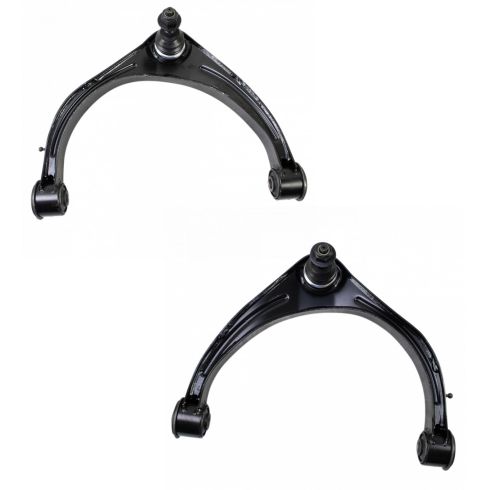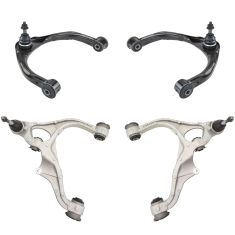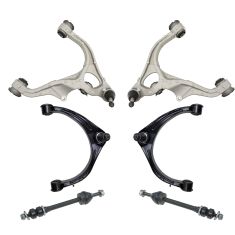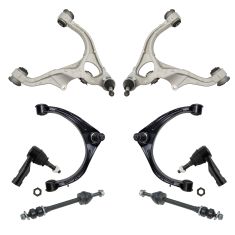1ASFK03542-Dodge Ram Front Driver & Passenger Side Upper 2 Piece Control Arm with Ball Joint Set TRQ PSA62539

Replaces
2018 Ram 1500 Truck Front Driver & Passenger Side Upper 2 Piece Control Arm with Ball Joint Set TRQ PSA62539

Product Reviews
Loading reviews
4.67/ 5.0
15
15 reviews
Control arms with upper ball joints
February 2, 2019
When someone goes online and makes a order they want two things: for it to arrive when scheduled and to be as advertised. 1A Auto accomplished bothWrite your review here. It must be at least 50 characters long. Consider whether you would recommend this product and what you like or dislike about it.
Easy to install / shipped quickly
April 25, 2019
These control arms were very easy to install. If you have an aging 1500 Ram and you work down rough roads, this is going to be something youll have to replace eventually, it was extremely easy to do. They are pretty beefy, not the absolute highest end, but theyll take a beating down west Texas oilfield roads with no problem.
The best thing I can say about using 1a auto is that their shipping seems like its the fastest in the industry. I definitely recommend using them for parts, especially if you are in a rush like I was, it took only 3 or 4 days for me to get these in the mail. I dont even get this kind of service from the auto parts stores in town here!
Great quality and quick shipping
October 4, 2020
ordered this when no one else had them and or was on backorder everywhere else.. great oem quality compared everything sode by side and it was all a perfect match. Went on perfectly and rides great
Exact Fit
January 14, 2021
Fit and finish is really good. Seems better quality than OEM.
April 5, 2022
Direct fit easy install
Fits perfectly
September 7, 2022
The driver and passenger control arm fit perfectly.
January 2, 2023
Shipped very fast went on like a glove. First time buyer from A1 will buy other parts from this company.
OEM quality
May 1, 2023
Price was great, shipping was fast. Product came well packaged and part was OEM quality. Installation was a breeze and results are amazing.
[{"url": "https://wac.edgecastcdn.net/001A39/prod/media/pNISJll75W64CYGsite/5ed0343d0dc38d9d179109cbe193feb0_1687108071588_0.jpeg", "caption": "No problem replacing the part."}]
June 18, 2023
Identical replacement part.
Great
July 12, 2023
Fit perfectly better than the oem that was on there easy install
Great buy
September 19, 2023
The control arms fit perfectly. The matched up perfectly and very easy to install. Very reasonably priced.
November 16, 2023
Excellent
Love 1AAuto
March 13, 2024
Fit perfectly, shipped quick
April 3, 2024
The ball joints in the control arms are coming loose! Faulty part!
Upper control arms
May 12, 2024
Great price. Decent bushing and ball joint. Installed with ease. Have no issues so far.
Customer Q&A
Can I put this on a 4x4?
December 11, 2017
10
Yes, these may be installed on a 4WD.
December 11, 2017
Alex P
Can you use these with a 4wd that has a 2.5 inch level on it?
January 25, 2018
10
Thanks for your question. All the parts we carry are made to work on factory suspension set ups only. Thank you!
January 25, 2018
Adam G
Does this fit a 2wd 2013 ram 1500 with a 3 lift?
July 19, 2020
10
Thank you for your inquiry. The parts we offer for sale are designed to fit and function on a vehicle that is at factory specifications. We cannot provide our fitment guarantee, nor any warranty coverage if the vehicle is modified in any way. Please let us know if you have any further questions.
July 20, 2020
A C
Is this for 4wd or 2wd?
August 19, 2020
10
Thank you for the inquiry. For the applications that these are listed to fit there is no difference in 4WD vs 2WD, these will be correct on both applications.
August 19, 2020
Curtis L
10
I installed them on a 4WD 2013
August 19, 2020
Manuel R
Will these fit and work on a 4 inch lift? 2015 Ram 1500
August 22, 2020
10
Thank you for the inquiry. These parts are made to original specifications and with a lifted or lowered suspension we would not be able to guarantee the fitment or longevity of the parts. We would recommend purchasing parts that are specifically made for modified suspensions.
August 22, 2020
Curtis L
Does this fit a rwd 2013 ram 1500?
July 4, 2021
10
Yes, according to the information you provided, this part will fit your vehicle.
July 5, 2021
Emma F
what material is the control arm made off?
July 4, 2023
10
Steel
July 5, 2023
Danny C
10
Hello, our parts are exact replacements for your vehicle's OEM parts. As long as your vehicle specifications match up with our listing, these parts will directly fit and function like the originals.
July 6, 2023
Ricale A
Will this fit a 2014 ram 1500 tradesman RWD v6?
December 19, 2023
10
Yes, this part will fit your vehicle.
December 20, 2023
Meghan R
Ram is a registered trademark of FCA US LLC. 1A Auto is not affiliated with or sponsored by Ram or FCA US LLC.
See all trademarks.















